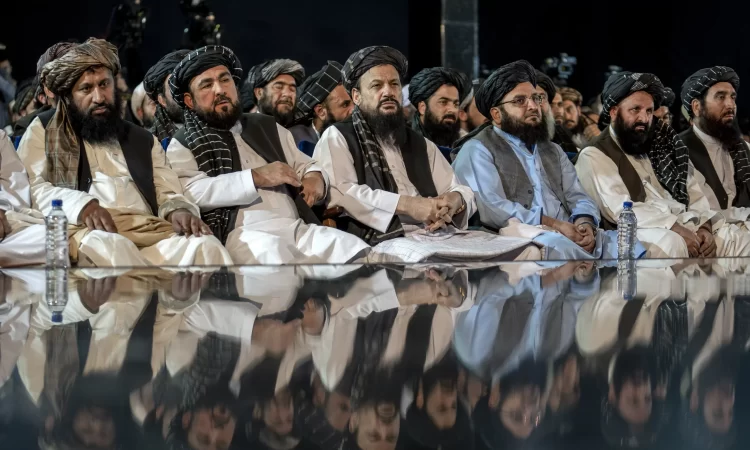
A recent audit from the Special Inspector General for Afghanistan Reconstruction found that two State Department bureaus “could not demonstrate compliance” with procedures for vetting partners carrying out humanitarian and development projects in Afghanistan. As a result, up to $293 million in U.S. taxpayer funds may have benefited the Taliban, which SIGAR emphasized “have sought to obtain U.S. funds intended to benefit the Afghan people through several means, including the establishment of nongovernmental organizations.”
The State Department performs risk assessments to vet implementing partners and “help mitigate the risk of State funds inadvertently benefiting designated terrorist organizations.” In some cases, bureaus may additionally use Risk Analysis Management counterterrorism vetting to further probe implementing partners’ possible ties to terrorists.
State Department agencies are required to retain contract files six years after final payments are distributed. A SIGAR spokesperson confirmed to the Washington Examiner that RAM vetting materials for entities selected as implementing partners must likewise be retained.
Two State Department bureaus, the Bureau of Democracy, Human Rights, and Labor and the Bureau of International Narcotics and Law Enforcement Affairs, were only able to provide partial vetting documentation.
DRL provided supporting documents for three of the seven awards it distributed between March 1 and Nov. 20, 2022. Of the three RAM vetting notices provided by DRL, two were deemed “in process.” Though four of 94 entities associated with those notices had not been deemed eligible, SIGAR reported that “DRL began implementing those awards” anyway.
INL only provided vetting information for three of the 22 awards it distributed in the same period. It provided SIGAR with RAM eligibility notices for three of the five RAM-eligible awards. SIGAR reported that one of the notices was “in process.” Five of the six organizations being considered for funds were not yet deemed eligible, but INL was “already implementing the award.”
State Department spokesman Matthew Miller rejected any indications that the department’s funds might have enriched the Taliban, saying at a press briefing last week that ”we flatly do not fund the Taliban.”
Whether the tranche of INR and DRL awards reached the Taliban, Afghanistan’s de facto government has already siphoned off $10.9 million in fees, taxes, and duties from $2.8 billion in humanitarian and development aid that the United States has provided since the Taliban came to power in August 2021, per SIGAR reporting.
The danger of U.S. funds reaching Taliban coffers is even more concerning, given findings about al Qaeda’s expanded Afghanistan presence in a July report from the United Nations. Since its last assessment, al Qaeda now operates training camps in two additional Afghan provinces, bringing to 12 the total number of Afghanistan’s 34 provinces where the U.N. believes al Qaeda operates training camps.
Bill Roggio, a senior fellow at the Foundation for Defense of Democracies, told the Washington Examiner, “It is highly likely that Al Qaeda is operating camps” in 15 provinces. Roggio said that Paktia, Paktika, and Khost are not mentioned in U.N. reporting but “are administered by the Haqqani Network, and al Qaeda operated camps there both pre-9/11 and during the U.S. presence in Afghanistan.”
“The Taliban is supporting al Qaeda camps in Afghanistan,” Roggio added. “These camps could not exist without the Taliban’s approval, and the Taliban is also providing material support and manpower to keep the camps running.”
The U.N. report says the continued relationship between al Qaeda and the Taliban is conducted “covertly in order to project the image of Taliban adherence to the provisions of the Doha Agreement.” The team shared a report that al Qaeda “sought to establish cooperation” with the East Turkistan Islamic Movement and Jamaat Ansarullah “in order to intensify activities and strengthen positions within Taliban military structures in the north to conduct joint operations and move the centre of terrorist activity to Central Asia.”
CLICK HERE TO READ MORE FROM THE WASHINGTON EXAMINER
The U.N. team also found that Taliban leaders “continue to profit” from the narcotics trade despite the ban on opium cultivation. Additionally, the team assessed that the Taliban were “unable or unwilling to manage the threat from Tehrik-e Taliban Pakistan” and may be unable to combat the Islamic State threat emanating from Afghanistan.
The West must not turn away from indicators that Afghanistan remains a narco-hub and training ground for multiple terrorist organizations. It is vital that the State Department fully vet its implementing partners and find ways to improve the lives of the Afghans suffering under the Taliban regime without enriching terrorists through taxpayer dollars.
Beth Bailey (@BWBailey85) is a freelance contributor to Fox News and the co-host of The Afghanistan Project, which takes a deep dive into nearly two decades of war and the tragedy wrought in the wake of the U.S. withdrawal from Afghanistan.






